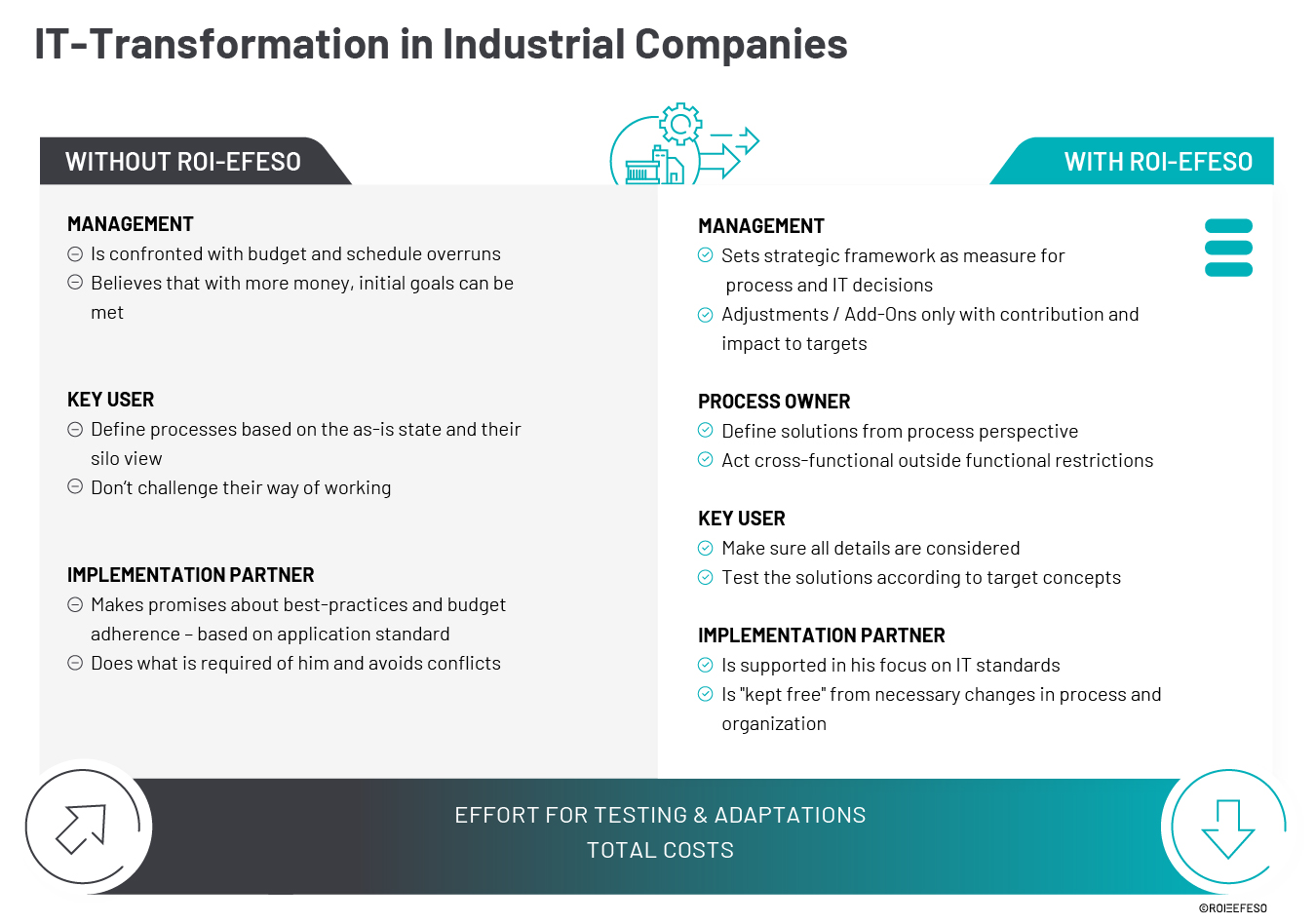
ENERGY BOOST FOR THE SAP S/4HANA TRANSFOMATION
Harmonization of the IT landscape in the global value creation network
A mechanical engineering company is stepping up the pace of its digital transformation: the entire global corporate network with locations in 40 countries is to receive a standardized, modern ERP platform.
The objective is to exploit the digital innovation potential with the switch from SAP R/3 to SAP S/4HANA. For example, to use real-time data in production, plan stock levels better or integrate machine learning technologies more quickly. For a change of course in the project, the company engaged ROI-EFESO as a consulting partner who is proficient in the IT and process dimensions of the task. This is revitalizing the transformation that has stalled in the meantime. After just one year, all locations went live.
Challenge
A mechanical engineering company wants to activate the digital innovation potential at its global locations by switching from SAP R/3 to SAP S/4HANA. Together with ROI-EFESO, it revitalized an ERP / MES transformation that had previously been started with another service provider and threatened to lead to a costly dead end.
MOREROI-EFESO solution approach
The project team set the transformation on a successful course in three stages: following a status analysis, it focused on the reorganization of the team and IT governance and accelerated the implementation phase with the application of best practice processes.
MORELessons learned
In addition to a consistent transfer of the solution approach, it proved to be critical for success to establish an end-to-end process orientation within the company. Additional improvements were achieved by raising (IT) employees' awareness of cost and operational risks.
MOREROI-EFESO success model
The business and IT perspectives were brought together in this project. The company significantly improved its existing processes – and solved technology-related tasks for the "digital excellence" of its IT platform.
MORESystem complexity leads to a dead end situation
As a manufacturer of tools and machines for processing metal components, the company, which was founded in Germany in 1950, is one of the global innovation leaders in its market. Today, approx. 2,000 employees generate sales of over 300 million euros. EUR in 40 countries around the world.
It was precisely this global presence that proved to be a key hurdle in the further development of the entire IT landscape to SAP S/4HANA. The aim was to gain clarity about the system complexity of the different ERP / MES systems in the plants, but also about the high variance of IT applications in the other operational areas of the sites. Here, the company also expected to rely on add-ons and site-specific IT applications that could become obsolete with the upgrade to S/4HANA.
The IT team undertook the first transformation steps with an implementation partner specializing in S/4HANA. This was focused on the fields of data migration and interface optimization and based on two classic but risky work hypotheses:
- "The user knows best how the company works" – and therefore provides the right orientation points for system design. Accordingly, the S/4HANA transformation focused on the implementation of individual requirements in modifications and the migration of existing system adaptations.
- "The new S/4HANA system does so much more" – and previous problems are solved at the touch of a button, improvements in business processing are achieved automatically.
These assumptions jeopardized the success of the project, as they directed the priority of implementation towards adapting the system to current, inefficient processes. Instead of focusing on improving processes and reducing the complexity of IT solutions in terms of flexibility, scalability and maintainability, there was a threat of system complexity being transferred.
The company recognized in good time that this path would lead to a costly dead end instead of to profitable improvements. It became clear that this project could not be managed with IT expertise alone, but also required in-depth, market-specific experience in the improvement of globally distributed operations processes. With the team from ROI-EFESO, the machine manufacturer has brought this reinforcement on board.
Re-organization according to "golden rules"
The project team consisting of IT and process managers and the consultants from ROI-EFESO put the transformation back on track for success in three stages.
Step 1 – Analyzing the status quo
The previous attempt to migrate a system with numerous open "adjustment points" to a new IT world proved to be a misstep. An analysis of the initial situation also revealed the following weaknesses and findings:
- All system adaptations reflect the wishes of the key users. However, they do not help to improve business processes – instead, they increase the complexity of the solution and limit scalability and maintainability.
- SAP standard solutions map the processes well – often "leaner" than required by the key users.
- There are no "golden rules" such as "standard before individual solutions" – however, using a standard solution that is only 80 percent complete can be more efficient than developing complex adjustments to the system.
- There is also no established IT governance – the key users drive and decide, not the key players in day-to-day business. However, these are relevant for the alignment of processes. For example, to achieve the shortest possible response time to customer requests on the delivery date. Or to avoid inefficiencies due to customer intervention in the product after the order has been placed.
The integration of end-to-end processes and data in order management reduced the costs for subsequent deliveries by millions.
Step 2 – Solution approach: Re-organization of team and governance
In this phase, the project team determined how the target processes were to be defined during the S/4HANA migration in order to achieve the business objectives in the best possible way – and which employees from the business units were specifically responsible for what. A division of tasks now creates clarity: the process owners are the leading authority in mapping the processes in the system.
The project team formulated a clear top priority for the newly introduced IT governance: the simplification and harmonization of processes and the use of IT must always be the top priority. To this end, it defined a set of "Golden Rules", according to which the standard is priority 1. Adjustments or add-ons may only be carried out in two exceptional cases: if a process cannot be mapped in any other way or if a verifiable contribution to the business is generated.
In this case, e.g. manual planning with XLS became obsolete at all planning levels by the consistent use of S/4HANA. Considerable savings in the use of working time resources was the result. In addition, the S/4HANA deployment reduced the costs for subsequent deliveries by millions by means of end-to-end processes in order management and monitoring.
The project team was able to reduce the costs for system adaptations, add-ons and interfaces from over 1,000 to less than 250 man-days.
Step 3 – Realization: Best-practice process mapping in the system standard
For the implementation in the global group of companies, the project team used supply chain mapping to create a clear picture of which different business transactions and process types are crucial for the best possible performance of the system. From over ten different historically grown business processes, it derived four ideal types of business: Make-to-Stock (MTS), Make-to-Order (MTO), Engineer-to-Order (ETO) and Service.
The team then defined the end-to-end target processes for each of these four business types and created premises for them: the task now is to eliminate the current media disruptions, simplify process handling and make consistent use of the SAP standard. In order to anchor this in the organization in the long term, a responsible employee was assigned to each type of business.
In addition, the project team adapted the IT development plan to the standard SAP deployment and the further development of the connected systems (CRM, PDM, etc.). This reduced the man-days originally calculated for the implementation of system adaptations and interfaces from over 1,000 to less than 250 days and lowered the total project costs by a further million. After just one year, the go-live was successfully completed – at all company locations worldwide.
Creating structures and managing risks
The following aspects proved to be particularly critical to the success of the project:
Transfer the ROI-EFESO approach consistently to the organization
Target processes must be aligned with the overarching strategy; this is where the process owners take the lead. The SAP standard always has priority 1, adaptations are only permitted in the two special cases. As an independent player, ROI-EFESO revitalized the S/4HANA transformation here – and simplified and harmonized the process landscape across all locations. Both the IT and business-related challenges were understood and solved.
Establish an end-to-end process orientation in the company
For the company, the establishment of end-to-end process responsibility in the four business types of MTS, MTO, ETO and Service proved to be a key element of the new IT infrastructure. This was accompanied by a move away from a purely functional organization based on system modules.
Raising awareness of complexity as a risk
The mechanical engineering company learned how important it is to sensitize (IT) employees to cost risks and operational risks that arise in the background due to complexity in processes and in the IT infrastructure. This also showed that a lack of IT expertise on the part of the process owners need not be an obstacle to process definition. On the contrary, it can focus on what the business actually needs in terms of IT applications – away from the solution idea and towards the result to be achieved in the business.
Combining business and IT perspectives
In this project, the combination of two services proved to be decisive for the successful completion of the project and for the results achieved after the go-live:
On the one hand, the project team concentrated on achieving "business excellence" in the sense of improving existing processes. The main drivers here were the harmonization, simplification, and automation of processes. For example, customer-oriented order creation has been standardized across all branches. The company also oriented towards best practice examples to utilize new solutions and eliminate complex, "dragged along" processes.
The project team combined this with technology-related tasks relating to the "digital excellence" of IT platform innovations. The primary aim here was to utilize new IT solution options for the company in order to create demonstrable added value. These include real-time synchronization of logistics and finance as well as integrated planning, production control and scheduling, which are implemented with SAP S/4 HANA.

